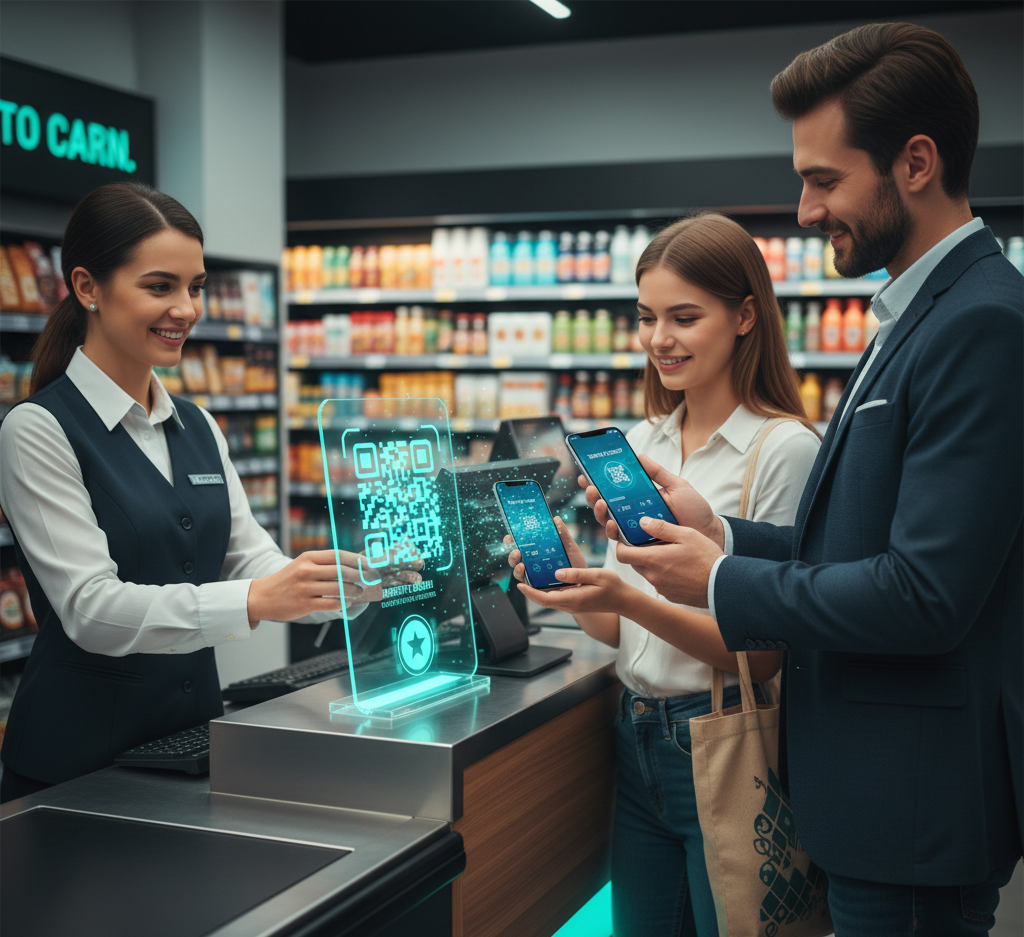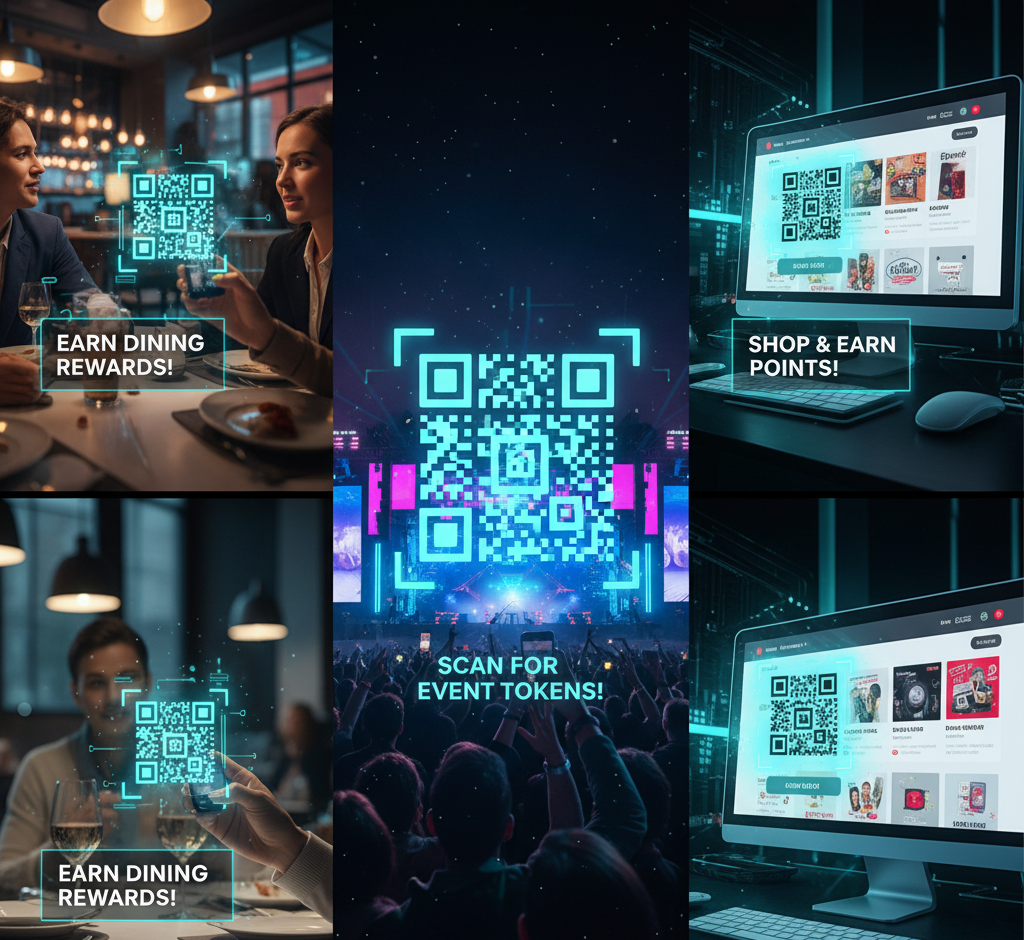Customer loyalty has changed more in the last few years than in the previous decade. The old world of punch cards, plastic loyalty cards, and heavy apps is being replaced by something much leaner and more flexible: QR code rewards programs. A simple scan now connects a customer to a complete loyalty experience, from instant rewards to long term relationship building.
What looks simple on the surface is backed by powerful analytics. Every scan becomes a trackable touchpoint that helps brands understand who is engaging, where, and when. Instead of asking customers to carry cards or install one more app, a QR rewards system plugs into the behavior they already have. They open the camera, scan, and the program does the rest.
This shift is not just about convenience. It changes how loyalty is designed and measured. Brands move from guessing which promotions drive repeat visits to seeing it in real time. Customers move from passive discount recipients to active participants in a rewards experience that adapts to their context.
What Is a QR Code Rewards Program?
A QR code rewards program is a digital loyalty system where customers earn points, benefits, or discounts by scanning QR codes placed on products, receipts, tables, packaging, signage, or marketing materials. Each scan can:
- Credit points to a customer profile
- Unlock an offer or discount
- Trigger a mission, challenge, or mini game
- Capture feedback or preferences
The core idea is that the camera becomes the loyalty entry point. A customer scans, the system identifies the context, applies the logic you defined, and responds with a reward or next step. No physical card to carry. No password to remember. No barrier between the moment of interest and the moment of engagement.

The evolution of loyalty programs
Loyalty programs started with paper punch cards. They were simple, tangible, and easy to explain, but also easy to lose or forget. The second wave brought plastic cards and brand specific apps. These added more features, but also more friction. Customers had to carry extra cards, remember which app belonged to which brand, and accept that every new program came with a new login.
The third wave is digital and camera first. QR codes became mainstream during the pandemic as a way to access menus and information without touching anything. Customers got used to scanning by habit. Now that behavior is being repurposed for loyalty. Instead of asking people to download yet another app, brands meet them where they already are: camera open, ready to scan.
In practice, this evolution means loyalty no longer needs to live in a separate channel. It can be woven into packaging, in store signage, printed receipts, business cards, table tents, and event badges. The program is always one scan away, visible at the exact moment when engagement makes sense.
How QR technology transforms engagement
Every QR scan creates a direct, measurable interaction. It tells you when and where the customer engaged, which code they used, how often they return, and which offers they respond to. That information is much richer than a generic email open or a simple click on a link.
Because QR codes work in both physical and digital spaces, they also create a single thread across channels. A customer might scan a code in a store, receive an offer, and later redeem it online. Another might discover a product through social media, then scan a code on packaging to join a loyalty mission. The same infrastructure connects those moments into one coherent journey.
When this data is fed back into your marketing stack, campaigns become more responsive. Instead of sending the same discount to everyone, you can tailor incentives based on real behavior: visit frequency, location, time of day, or products scanned. Engagement stops feeling random and starts feeling designed.
Turn scans into loyalty from day one
Launch QR rewards that recognize users instantly and personalize offers across locations and moments.
Key Benefits of QR Code Rewards Programs
The strongest QR loyalty programs do three things at once. They make participation feel effortless for customers, reduce operational complexity for teams, and create better data for decision making. Together, these benefits compound into higher engagement and more efficient spend.
Frictionless user experience
Most loyalty programs fail at the starting line. The ask is too big for the value that is visible. Download an app. Fill out a form. Create a password. Confirm your email. Many customers simply opt out.
QR based programs invert that sequence. The first interaction is a small, low friction action: scan the code and see what happens. From that moment, the system can show a reward, a progress bar, or a mission that makes it clear why it is worth engaging. If identification is needed, it can happen later, once trust is built.
Because the entry point is universal and does not depend on a specific store device, these programs scale across locations and partners without extra training. The same basic behavior works in a flagship store, a pop up booth, a partner location, or a printed flyer.
Real time analytics and personalization
Every scan is a data point, and scans add up quickly in a healthy program. Over time, patterns emerge:
- Which locations drive the most engagement and redemptions
- Which time slots and days of the week peak for scanning
- Which types of offers convert best for different segments
- How often customers return and how that correlates with rewards
With the right platform, this data does not just sit in reports. It flows back into the reward logic. Customers who scan mostly in the morning can receive morning specific offers. High frequency visitors can be moved into higher tiers automatically. New customers can be guided through onboarding missions that teach them how to earn more value.
The result is a loyalty experience that feels like it is adapting over time rather than repeating the same static pattern.
Cost savings vs. traditional loyalty cards
Physical loyalty programs come with hidden costs. Cards need to be printed, shipped, and replaced. Hardware needs to be installed at checkout. Apps require development, updates, and customer support. Even small issues, like forgotten passwords, become recurring costs for support teams.
QR based rewards programs simplify this stack. A QR image can be reused across materials at effectively zero extra cost. There is no special scanner to maintain, as the customer brings the device. New campaigns do not require a new card or a new app version, just updated rules behind the same code.
For smaller businesses, this cost structure can be the difference between having a loyalty program or never launching one. For larger organizations, it frees budget to invest in better rewards and more creative experiences instead of infrastructure.
Multi level engagement and gamification
QR rewards are not limited to simple point accumulation. They open the door to experiences that look more like games and less like traditional discount grids. A few practical patterns:
- Scavenger hunts. Customers earn extra rewards by finding and scanning multiple codes across a store, mall, event, or campus.
- Tiered programs. Scan frequency, visit streaks, or mission completion can unlock new status levels with better perks.
- Referral trees. Each customer gets a personal QR code that friends can scan to join. The system tracks who referred whom and splits rewards accordingly.
- Time limited boosts. For a set window, scans might earn double points, bonus tokens, or access to hidden items.
These mechanics tap into simple psychology. Customers like to complete sets, hit milestones, and see progress. When you align these instincts with business goals, engagement becomes less about chasing discounts and more about participating in an ongoing experience.
Pilot a QR rewards campaign in days
Spin up a test, compare uplift against static QR, and scale the mechanics that actually move behavior.

Practical Use Cases
QR code rewards programs can be adapted to almost any industry, but some verticals see especially strong results. Below are four categories where QR driven loyalty can shift both customer experience and economics.
Retail and e commerce
In retail, QR codes turn shelves, displays, and packaging into interactive surfaces. Customers can scan to:
- Learn more about a product or collection and earn points for exploring
- Access size guides, styling tips, or how to content after purchase
- Join a loyalty program directly from a bag, tag, or receipt
At checkout, a QR printed on the receipt can trigger a short survey. Completing it earns bonus points and gives the retailer fresh feedback without paying for a separate panel. For e commerce brands, codes included in shipping boxes turn unboxing into another engagement point. Customers can scan to register products, unlock care instructions, or receive an offer on their next order.
QR codes in retail loyalty programs also support inventory aware promotions. A slow moving product can carry a dynamic QR that offers a sharper incentive, while popular items might simply connect customers to a softer upsell or community channel.
Restaurants and hospitality
Restaurants were among the first to normalize QR scanning at the table. Extending that behavior into rewards is a natural next step. Diners can:
- Scan table codes to join a program, earn points, and see specials
- Collect visit stamps that convert into free items or exclusive menu experiences
- Leave quick feedback without downloading anything or writing long reviews
High frequency customers can be quietly upgraded into VIP tiers that unlock priority seating, early access to events, or surprise rewards. For cafes and coffee shops, QR based stamp cards remove the hassle of physical cards while still delivering the familiar feeling of progress toward a free drink.
Hotels and other hospitality brands can use QR codes across rooms and shared spaces to guide guests through amenities and reward exploration. A guest who scans codes at the spa, restaurant, gym, and co working space could unlock a special perk that encourages longer stays or repeat bookings.
QR code rewards for restaurants provide operators with real visit data. Instead of guessing which promotions bring people back, they can measure visit intervals, favorites, and response to daypart specific offers.
Events and entertainment
Events are dense with potential touchpoints. QR rewards help organizers use that density to build ongoing relationships instead of running one off experiences. A few examples:
- Scans at registration, sessions, and sponsor booths each award points
- Attendees who complete a path of scans unlock access to a lounge or VIP area
- In stadium codes connect in person actions to digital profiles and content
Concerts and festivals can place codes at bars, merch stands, and photo backdrops. Fans earn points for moving around the venue and engaging with partners. Organizers see flow patterns, which activations attract attention, and which sponsors get real foot traffic.
Sports teams can reward season long behavior, not just single game attendance. Codes on tickets, seats, and digital channels can all feed into one engagement profile where streaks, loyalty, and referrals translate into access and status.
Education, health, and nonprofits
QR rewards are not limited to commercial sales. They can also support participation, wellness, and community building.
- Education. Students earn points for attending events, workshops, office hours, or support sessions by scanning codes at each location.
- Health and wellness. Clinics and insurers award points for preventive actions such as screenings, vaccination campaigns, or fitness challenges.
- Nonprofits. Volunteers and donors scan to check in at events, log hours, and unlock recognition tiers or behind the scenes updates.
In these contexts, rewards can be less about discounts and more about access, recognition, or support. The same QR infrastructure powers behavior change at scale.
See examples for your vertical
Browse ready to run ideas for stores, restaurants, and live events, then clone a template that fits your reality.
Why VISU Wins the Rewards Game
On the surface, many tools can create a QR code. The real difference appears when you look at what happens after the scan. Generic QR generators and traditional loyalty platforms tend to solve only one part of the problem. VISU is designed to connect the entire chain: scan, engagement, attribution, and shared value.
Generic QR services like Bitly or QR Code Generator focus on creating a scannable image that redirects to a URL. They are useful building blocks, but that is where they stop. There is no rewards engine behind the scan, no multi party revenue sharing, limited analytics, and no easy way to manage complex campaigns. Everything beyond the click has to be built somewhere else.
Traditional loyalty platforms, on the other hand, usually live inside a closed ecosystem. They may require specific hardware at checkout, monthly subscription fees, and sometimes even lock you into a single payment provider. They can be effective, but they are often rigid and hard to extend into partners, pop ups, or independent creators.
VISU takes a different approach. It combines the simplicity of QR scanning with an architecture built for dynamic rewards and multiple stakeholders. The platform is hardware agnostic and platform neutral. You can generate as many codes as you need and decide what each scan should do based on:
- User history and segment
- Location and context
- Time of day or date range
- Campaign rules and budgets
VISU connects with existing tools via APIs instead of asking you to replace them. A restaurant can keep its current ordering system and add VISU for rewards. A retailer can maintain its payment processor while using VISU to manage QR based missions, tiers, and referral trees.
From a return on investment perspective, the model is built to multiply value rather than direct it to a single party. A single reward budget can:
- Benefit the end customer through points or tokens
- Reward the QR code owner or host location
- Credit the referrer who brought either side into the network
- Feed into $VISU based rewards that strengthen the ecosystem
This multi layer structure turns each campaign into a shared incentive system, which is especially powerful when you work with partners, creators, and affiliates.
VISU also brings clarity to a classic blind spot: offline to online attribution. Imagine a coffee shop that places QR codes on takeaway cups. With generic marketing, there is no way to know if those cups influence later online orders or social engagement. With VISU, each scan is tracked and future actions can be tied back to that initial interaction. You see which locations, creatives, and channels actually drive revenue, not just impressions.
On top of this, VISU supports QR code Ads with built in fraud prevention and redemption controls. You can create single use codes, time limited offers, or capped campaigns that automatically stop once a budget threshold is reached. That reduces abuse, keeps discounts under control, and builds trust for both brands and partners.
| Capability | Generic QR / Legacy Loyalty | VISU Rewards |
|---|---|---|
| Personalization | Static destination | Rules, segments, dynamic routing |
| Attribution | Basic clicks | Scan to funnel to revenue |
| Reward Model | Single party | Users, QR owners, referrers |
| Anti fraud | Limited | Single use, caps, redemption tracking |

Getting Started with VISU
Launching a VISU powered rewards program does not require a long implementation project. The platform is designed so that teams can go from idea to live campaign in a short time, then iterate based on real data.
The process starts with creating a VISU account and defining your first campaign. You choose:
- Which action you want to encourage, such as a visit, purchase, sign up, or referral
- What type of reward you want to offer, from fixed points to percentage based rewards or variable drops
- Which segment or context each reward should apply to
VISU then generates QR codes connected to those rules. You can export them in formats suited for posters, packaging, digital screens, table tents, or business cards. Because routing is dynamic, you can change what the code does later without reprinting.
Next come placements. Retailers place codes near key products, at checkouts, and on receipts. Restaurants add them to menus, table displays, and take away bags. E commerce brands include them in shipping boxes and confirmation emails. Event organizers print them on tickets, schedules, and signage in high traffic areas.
As customers start scanning, your VISU dashboard begins to fill with live metrics. You see which locations and placements perform best, how many scans turn into sign ups or redemptions, and which campaigns generate the most value for the rewards you spend. Underperforming codes can be updated with new offers or repositioned, while top performers can receive extra support and budget.
For brands that work with influencers, creators, or affiliates, VISU issues unique referral QR codes. Each partner gets a code that tracks the customers they bring in and how those customers behave over time. Commissions and incentives can then be tied to actual performance instead of estimated reach.
Over time, you can move from single campaigns to a full portfolio of always on and seasonal initiatives. For example:
- A base loyalty program that rewards everyday visits and purchases
- Short term boosts around holidays, launches, or local events
- Location specific missions that reflect neighborhood behavior
- Reactivation campaigns for customers who have stopped scanning
All of this rolls into one analytics view, so you can see not just which campaigns work in isolation, but how they combine to support customer lifetime value and partner economics.
Start building smarter loyalty now
Create, track, and reward every scan without extra apps or hardware, and with full visibility on what works.
FAQ: QR Code Rewards Programs
How do QR code rewards programs work?
Customers scan a QR code to instantly earn points, discounts, or rewards. Each scan updates their account and delivers personalized offers, without requiring an app or physical card.
Do I need a dedicated app or software?
No. QR codes work natively with any modern smartphone camera. VISU handles tracking, analytics, reward logic, and campaign management in the background.
Can QR code rewards integrate with my existing POS or CRM?
Yes. VISU supports integrations with popular CRM and POS systems through APIs, so customer and reward data can sync with the tools you already use.
What industries benefit most?
Retail, restaurants, events, and e commerce tend to see the fastest ROI. VISU also powers engagement programs for education, healthcare, and nonprofits.
How does VISU differ from generic QR platforms?
Generic tools stop at the click. VISU adds multi layer rewards, $VISU tokenization, gamification, anti fraud controls, and detailed analytics that turn every scan into measurable shared value.

